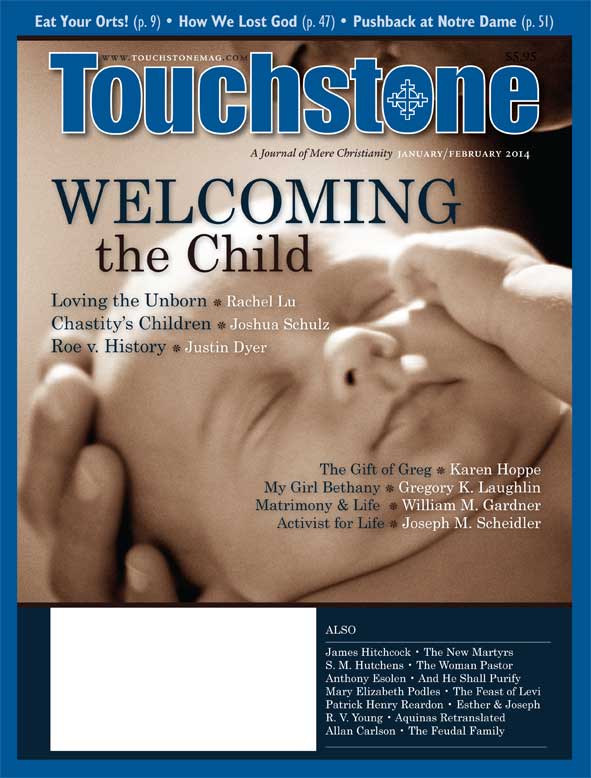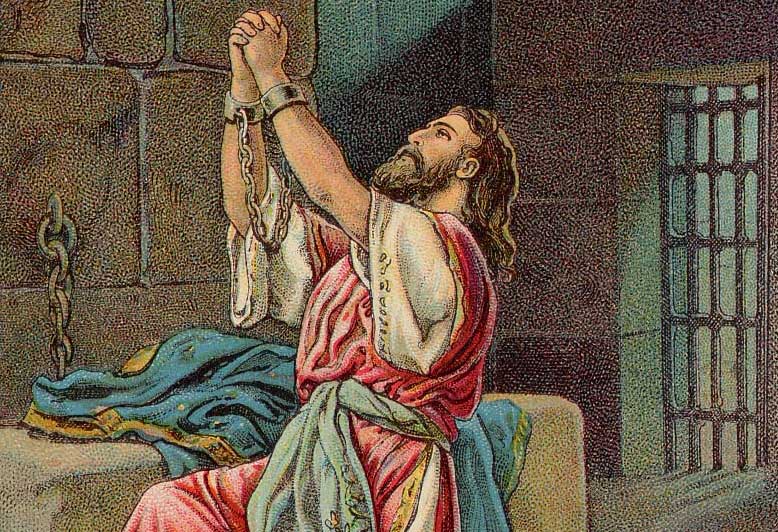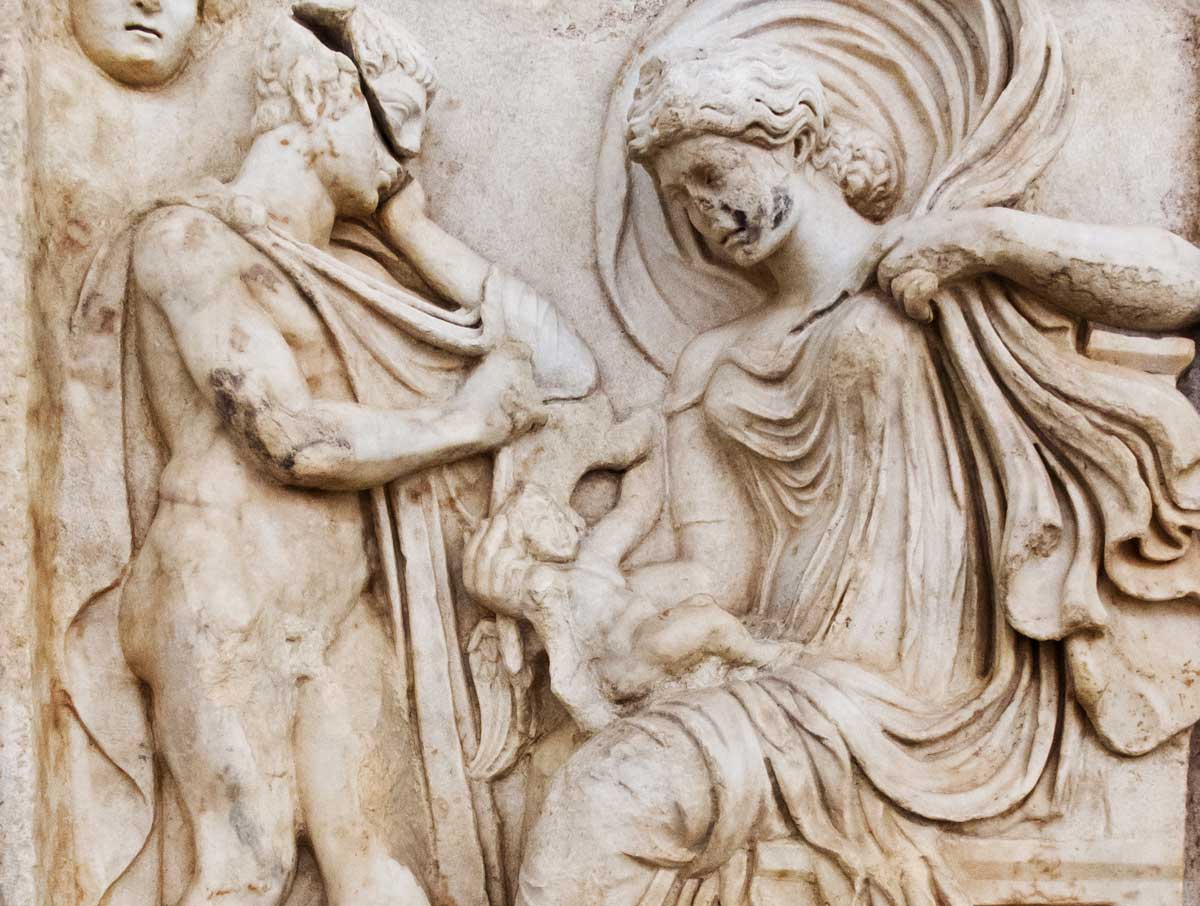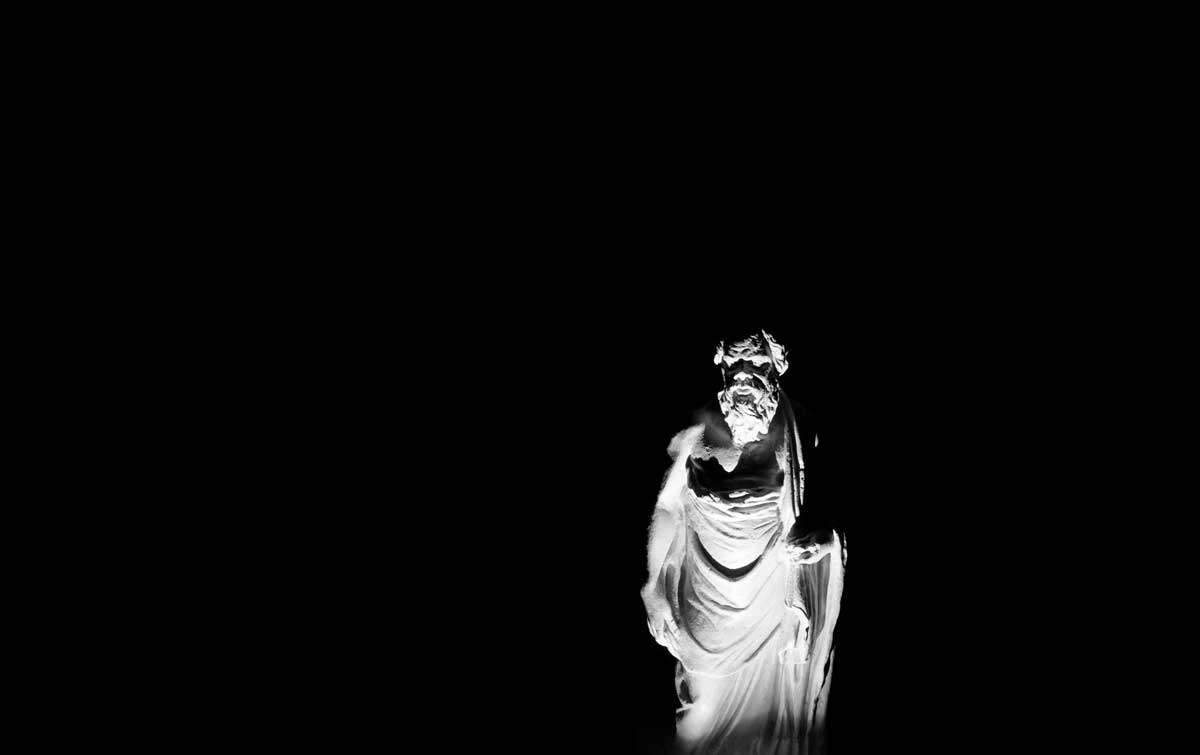Feature
Roe v. History
How the U.S. Supreme Court Falsified the Record of Legislation Protecting Life
On an otherwise ordinary morning in the summer of 1970, a divorced and abandoned woman named Pixie went into labor in a Dallas hospital. A self-described "rough woman, born into pain and anger and raised mostly by [herself]," Pixie had spent the last few years as a barker "running the freakshow at the Bluegrass Carnival." Though she was young, Pixie had already lived a tough and troubled life, and now, at age twenty-one, she was the mother of three girls born to three different fathers.
Young, scared, and alone, Pixie had initially asked her obstetrician simply to make her "not pregnant." To her dismay, Pixie was told that in Texas it was illegal to perform an abortion that was unnecessary to save her life, and, admittedly, her life was not in danger. Through a series of events that began with a referral to a Dallas adoption attorney, she then ended up at Columbo's Pizza Parlor seated across from two young, idealistic attorneys searching for a lead plaintiff for a class-action lawsuit challenging the constitutionality of Texas's restrictive abortion law.
In a decision that changed her life, Pixie—whose legal name is Norma McCorvey—agreed to participate. The pregnant, twenty-one-year-old carnival worker assumed the pseudonym Jane Roe in a lawsuit filed against Dallas District Attorney Henry Wade, and nearly three years later—long after McCorvey had given her third daughter up for adoption—the case of Roe v. Wade was decided in her favor. On January 22, 1973, the Supreme Court of the United States announced in a 7–2 decision that the Constitution protected the right of Jane Roe to terminate her pregnancy, and the Texas law banning elective abortions, along with similar state laws across the country, was deemed unconstitutional.
The Court's decision in Roe was buttressed by the published research of law professor Cyril Means, who claimed that abortion was a traditional common law liberty in America and that nineteenth-century abortion statutes (such as the statute on the books in Texas) were solely designed to protect the health and safety of women and not to preserve the lives of unborn children. These claims were as dubious in 1973 as they are today, but they continue to inform law, scholarship, and commentary at the highest levels. The forty-first anniversary of Roe v. Wade offers as good a time as any to shed disinfectant light on what has become orthodox abortion history in many quarters of the academy.
Creating the New Narrative
Shortly after Norma McCorvey filed her lawsuit against the Dallas District Attorney, inaugurating what would become the landmark case of Roe v. Wade, a similar case was docketed for the Northern District Court of Ohio. In Steinberg v. Brown (1970), a pregnant twenty-one-year-old welfare recipient with a dependent child at home and an estranged husband (along with a physician, a psychiatrist, a social worker, and a minister) initiated a class action lawsuit challenging the constitutionality of Ohio's long-standing abortion ban.
"No person," the Ohio Revised Code stipulated, "shall prescribe or administer a medicine, drug, or substance, or use an instrument or other means with intent to procure the miscarriage of a woman unless such miscarriage is necessary to preserve her life, or is advised by two physicians to be necessary for that purpose." In this case, a three-judge federal court was asked to declare Ohio's anti-abortion statute unconstitutional. The right to privacy protected by various provisions in the Bill of Rights and made applicable against the states by the Fourteenth Amendment, it was argued, protected the right of Ohio women to seek and obtain abortions free from state legislative interference.
Yet a bill to revise and strengthen the restrictive abortion law at issue in Steinberg had been passed by the Ohio state legislature on April 16, 1867—just four months after the same legislature had voted to ratify the Fourteenth Amendment. Similar abortion laws existed in state codes throughout the country when Secretary of State William Seward certified that the required three-fourths of state legislatures had also voted for ratification. Those same abortion statutes had remained on the books, largely unchanged, until the legal challenges of the 1970s. For jurists and scholars adhering to traditional canons of constitutional interpretation, an obvious question emerged: How could a statutory regime in place in 1868 and left undisturbed for over a century be deemed unconstitutional?
In an attempt to meet this challenge, the general historical narrative that was developed by advocates of abortion reform was twofold. First, they suggested that the exclusive reason for nineteenth-century state abortion laws (like the Ohio statute in question) was to protect women from dangerous surgeries and abortifacient drugs and not to protect or safeguard the lives of unborn children (who, it was claimed, were always considered to be non-persons by the law). Second, legal reformers insisted that abortion was a traditional common law liberty in England and America. Because advances in medical technology had made abortion relatively safe for women, it was urged that judicial decisions striking down these century-old laws would fulfill the spirit of the original statutes (i.e., to protect women) while maintaining an essential continuity with the Anglo-American constitutional tradition. This narrative, in turn, provided the foundation for the decision in Roe v. Wade.
Cyril Means's "Revelations"
The reasons that historically had been advanced to justify state abortion restrictions, Justice Harry Blackmun asserted in his Roe opinion, were to (a) discourage illicit sex, (b) regulate a medical procedure that was inherently dangerous for women, and (c) protect prenatal life. According to Blackmun, however, the first concern was anachronistic and "no court or commentator [had] taken the argument seriously"; the second was rendered moot because of advances in medical technology that made abortion safer for women; and the third was "sharply disputed" owing to an alleged "absence of legislative history." Appealing to two of New York Law School Professor Cyril Means's academic articles, Blackmun even noted that there was "some scholarly support" for the view that the "original purpose" of the state anti-abortion statutes was solely to protect women and not unborn children.
While serving as legal counsel to the National Association for the Repeal of Abortion Laws (NARAL), Means wrote his legislative history of abortion statutes with the stated goal of providing judges with a historical foundation for a new constitutional abortion regime. As Means readily admitted, the notion that the unborn child was "itself an object of protection by our criminal law" was a "common assumption" in 1968. In an article for the New York Law Forum, however, Means purported to reveal "for the first time" that the true purpose of state anti-abortion statutes was only to protect the life and health of the mother. In a companion article published three years later, Means summarized his "original contribution":
[T]he revelation of a truth that had been long forgotten: that the sole historically demonstrable legislative purpose behind these statutes was the protection of pregnant women from the danger to their lives imposed by surgical or portional abortion, under medical conditions then obtaining, that was at times as great as the risk to their lives posed by childbirth at term, and that concern for the life of the conceptus was foreign to the secular thinking of the Protestant legislators who passed these laws.
In his second article, Means claimed to have uncovered a related "story, untold now for nearly a century" that "English and American women enjoyed a common-law liberty to terminate at will an unwanted pregnancy, from the reign of Edward III to that of George III," and this "common-law liberty endured . . . in America, from 1607 to 1830." The upshot of Means's history was clear enough. Speaking of the Georgia case of Doe v. Bolton and the Texas case of Roe v. Wade (which were both scheduled for oral argument at the Supreme Court) Means concluded: "Should the merits be reached in either case, counsel and the Court may find the present conspectus of the Anglo-American legal history of abortion of assistance; for, only if in 1791 elective abortion was a common-law liberty, can it be a ninth-amendment right today."
The Historians' Brief Repeats Means
The problem was that Means's two central claims about the history of abortion law were simply not true. No court in England or America ever considered abortion (even if unindictable) to be a protected common-law liberty, and the primary purpose of anti-abortion legislation was unequivocally to protect the lives of unborn children, who were considered to be both human beings and legal persons by the doctors who proposed and lobbied for, and the legislators who passed, restrictive abortion statutes in the mid-nineteenth century.
The two main tenets of Means's narrative—that abortion was a common-law liberty at the time of the American founding and that the sole purpose of nineteenth-century anti-abortion statutes was the protection of women—have helped to sustain the current abortion regime by purporting to connect it with America's constitutional past. A good example of this continued effort to connect post-Roe abortion jurisprudence to America's past social practices is in an amicus brief signed by several hundred historians and submitted to the Supreme Court for the case of Webster v. Reproductive Health Services (1989). After insisting that "constitutional principles require examination of our history and tradition as a Nation to determine the existence and contours of fundamental constitutional rights," the Historians' Brief repeated Means's twin claims that "nineteenth-century laws restricting access to abortion were not based on a belief that the fetus is a human being" and that "the common law recognized a woman's right to choose abortion."
The Historians' Brief, in turn, has informed some of the most influential scholarship on jurisprudence and constitutional law, including the works of such prominent scholars as Ronald Dworkin and Laurence Tribe, and a shared commitment to this false narrative about America's history and traditions has been a crucial aspect of the creation and maintenance of constitutional abortion rights.
Means's Phoenix
"In ancient Eastern folklore," Means recounted in 1971, "the phoenix was a fabulous bird, said to live for five hundred years in the Arabian desert, then to build its own funeral pyre, on which it would burn itself to ashes, out of which it would then arise young again." In anticipation of the Court's decision in Roe, Professor Means suggested that the life of the abortion liberty in America might soon come to resemble that of the mythical phoenix.
In the early days of the republic, Means argued, "American women enjoyed a common-law liberty to terminate at will an unwanted pregnancy," but the traditional liberty to abort had been reduced to ashes by restrictive abortion laws passed in the mid-nineteenth century. There were, however, new challenges to state abortion laws afoot in the courts, and Means offered his "legal history of abortion" to assist "counsel and the Court" in their deliberations.
When the cases were heard, counsel and the Court did indeed take notice. The Justices reportedly had copies of Means's article with them on the bench, Roe's attorney, Sarah Weddington, appealed to Means's history as authoritative during oral arguments, and Blackmun cited Means seven times in his official opinion for the Court.
Additionally, nearly half of Blackmun's opinion involved an inquiry into "medical and medical-legal history," and the Court's decision rested, in part, on the premise that in the founding era "a woman enjoyed a substantially broader right to terminate a pregnancy than she does in most States today." The Court appealed to Means's historical research to support this claim. As Weddington later recalled of her reaction when the opinion was released, "I had not been reading the extensive footnotes at the bottom of each page closely, but sure enough, when I did I found several referring to Cyril Means's writings; I knew he would be pleased."
Steinberg & Its History
However, the history of the legislation at issue in Steinberg v. Brown (the Ohio case described above) demonstrates the absurdity of Means's novel claim that concern for the life of the fetus is only a product of the mid-twentieth century. The record clearly demonstrates that the legislators who passed the statute in question were motivated, at least in part, by a desire to protect what they deemed to be unborn children. A report issued by the Ohio Senate Committee on Criminal Abortion and reprinted in the appendix to the state legislative journal described abortion as "child-murder" and noted that the best available scientific evidence suggested that a "foetus in utero is alive from the very moment of conception."
To "extinguish the first spark of life," the committee further maintained, quoting the English physician Thomas Percival's 1803 Medical Ethics, "is a crime of the same nature, both against our Maker and society, as to destroy an infant, a child, or a man." The reason for the statute, which made no "unnatural and unscientific distinction" between pre-quickening and post-quickening abortion, was simple: "The willful killing of a human being, at any stage of its existence, is murder."
The men who voted to approve this bill and ratify the Fourteenth Amendment in the same legislative session apparently saw no contradiction between the two. Nor did Federal District Judge Don Young see a contradiction between the Fourteenth Amendment and Ohio's restrictive abortion measures when he was tasked with writing the opinion in Steinberg. "Once human life has commenced," the Johnson appointee and self-described liberal Democrat declared, "the constitutional protections found in the Fifth and Fourteenth Amendments impose upon the state the duty of safeguarding it."
It was one thing to promulgate a right to marital privacy that encompassed a general right to use contraception, as the Court had done a few years earlier in Griswold v. Connecticut (1965). It was quite another to extend the principle to cover abortion. Contraception, as Young noted, is "concerned with preventing the creation of a new and independent life." But once the "preliminaries have ended, and a new life has begun," Young argued, a human being exists who may be deliberately and lawfully killed only in a situation that would otherwise justify homicide.
Given the substance of Judge Young's opinion and the legislative history of the Ohio abortion statute, it was strange, then, that the majority in Roe claimed "no case could be cited that holds that a fetus is a person within the meaning of the Fourteenth Amendment"—before citing Steinberg v. Brown to support the claim that "the word 'person,' as used in the Fourteenth Amendment, does not include the unborn."
Mohr's Ambiguity
In his seminal history of nineteenth-century abortion law, published five years after Roe, James Mohr initially cast doubt on some aspects of Means's history, noting that
Means, who was openly trying in 1968 to build a case upon which New York state courts might invalidate anti-abortion legislation on the grounds that twentieth-century medicine had rendered an abortion every bit as safe or safer than a full-term delivery, was less than convincing on several points.
As Mohr pointed out, the physicians who lobbied the state legislatures to pass restrictive abortion statutes in the mid-nineteenth century "felt very strongly indeed on the issue of protecting human life," and they "defended the value of human life as an absolute."
As a serious historian, Mohr would not obfuscate the centrality of human life to the nineteenth-century anti-abortion movement, but his ambiguous treatment of the common law in key parts of his book did further the notion that abortion was a protected liberty in the early Republic. In the year 1800, Mohr wrote, "no jurisdiction in the United States had enacted any statutes whatsoever on the subject of abortion; most forms of abortion were not illegal and those American women who wished to practice abortion did so." In a reflection on the Supreme Court's decision in Roe, Mohr similarly concluded that the "anti-abortion laws of the late nineteenth century were the real aberrations in the history" of American abortion policy.
As John Noonan noted the following year, one "peculiarity of Mohr's Abortion in America is to speak at times as though 'laws' in the United States did not include the common law." Though in other places Mohr did recognize that abortion after quickening was always a common-law offense, his seemingly contradictory thesis that in the nineteenth century the United States had transitioned "from a nation without abortion laws of any sort to a nation where abortion was legally and officially proscribed" did much to cement the myth that abortion was a traditional American liberty and that anti-abortion sentiment was merely one idiosyncrasy of the mid-nineteenth century. The research of John Keown and others has demonstrated, however, that "the weight of available authority supports the view that the common law prohibited abortion, at the latest, after the fetus had become 'quick' or 'animated.'"
Quickening & the Law
The quickening distinction, which was abandoned in most American jurisdictions by the end of the nineteenth century, Keown notes, in turn "betrayed both pragmatic and metaphysical influences." According to general rules of evidence, an abortion conviction required proof that the fetus was alive when the abortive act took place and that the abortive act was the cause of death. In the absence of modern technology, quickening (or the felt movement of the fetus by his or her mother) was often the best available evidence of new life (and thus the starting point for any criminal abortion prosecution).
Relatedly, a residual theory held in common by Aristotle and the medieval Church, but disproved by nineteenth-century science, was that a distinct human being came into existence after fetal animation or movement. The quickening requirement, coupled with the theory of animation, provided the foundation for Blackstone's oft-quoted line that life—a "right inherent by nature in every individual"—"begins in contemplation of law as soon as an infant is able to stir in his mother's
womb."
The anti-abortion legislation in the mid-nineteenth century, then, was not so much an aberration as a development. The principles underlying the traditional rules for abortion prosecutions at common law were twofold: (a) after a distinct human being came into existence his or her willful destruction was a serious crime, (b) provided that proof of the existence of new life and its willful destruction could be obtained.
It is true that before legal rules governing abortions were written down in statutes, American judges often interpreted the common-law emphasis on quickening to preclude prosecutions for attempts at early abortion, agreeing with the Massachusetts Supreme Court that "at common law, no indictment will lie, for attempts to procure abortion until [a woman] is quick with child." Statements such as this indicate that abortion, in many cases, was not considered an indictable offense before the detection of fetal movement, but this is quite different from the claim that abortion was something akin to a protected liberty (or "right" as Blackmun characterized it). Although "not punishable at common law," Chief Justice Lemuel Shaw wrote for the Massachusetts Court in Commonwealth v. Parker (1845), attempts at pre-quickening abortion were still held to be "offensive to good morals and injurious to society."
Advance in Knowledge, Not Principle
Partly as a response to Chief Justice Shaw's decision, the Massachusetts legislature later passed a law making it a statutory crime to attempt to "procure the miscarriage of any woman" regardless of quickening. Still, many states in the mid-nineteenth century did continue to rely on the quickening distinction for purposes of criminal prosecution. When it was suggested by counsel in an 1856 Iowa case that an unborn child should be protected under a statute that prohibited the killing of "any human being with malice aforethought," for example, Chief Justice (and future Senator) George Wright responded that an infant "in ventre sa mere" (i.e., in the womb of his mother) was "not a human being within the meaning" of Iowa's murder laws—at least "not such before it is quick in the womb."
As a matter of positive law, Justice Wright was perhaps correct that Iowa's murder statutes were not intended to encompass abortion—and, like Massachusetts a decade earlier, the Iowa legislature soon approved a separate ban on "foeticide" (without making a distinction for quickening). Nevertheless, as James Witherspoon has demonstrated, at least seventeen state codes in the nineteenth century did denominate "acts causing the death of an unborn child 'manslaughter,' 'murder,' or 'assault with intent to murder,'" and by mid-century the quickening requirement was increasingly thought to be in tension with the best available science and with the principles underlying the traditional common-law categories.
As Francis Wharton explained in his mid-century treatise on criminal law,
It has been said that it is not an indictable offence to administer a drug to a woman, and thereby to procure an abortion, unless the mother is quick with child, though such a distinction, it is submitted, is neither in accordance with the result of medical experience, nor with the principles of the common law.
It was not in accordance with medical experience because the medieval theory of animation had long since been discredited, and it was not in accordance with the principles of the common law because the traditional categories had presupposed the moral axiom that one should not destroy innocent human life. As Wharton wrote in a separate treatise on medical jurisprudence, the quickening distinction, undergirded by the theory of animation, was "explicable in the infancy of physiological science, by an inadequate knowledge of the development of the embryo," but it "should now, when ignorance is no longer excusable, disappear from our penal system." From this perspective, then, there had been no alteration of principle in the nineteenth century—only an advance in knowledge.
Storer's Critique
Motivated in large part by concerns that the public was ignorant of the emerging facts of embryology, a group of nineteenth-century physicians and lawyers began to argue that the old quickening requirement should be abandoned as arbitrary and ultimately misguided. The "whole question of the criminality" of abortion, Horatio Storer wrote in his 1868 Criminal Abortion,
turns on this one fact,—the real nature of the foetus in utero. If the foetus be a lifeless excretion, however soon it might have received life, the offence is comparatively as nothing: if the foetus be already, and from the very outset, a human being alive, however early its stage of development, and existing independently of its mother, though drawing its sustenance from her, the offence becomes, in every stage of pregnancy,
MURDER.
From this basis, Storer criticized the traditional quickening distinction, insisting that by the common law and by many of the state criminal codes "foetal life, per se, is almost wholly ignored, and its destruction unpunished; abortion, in every case, being considered an offence mainly against the mother, and as such, unless fatal to her, a mere misdemeanor, or wholly disregarded."
Storer was particularly critical of the common categorization of abortion as a misdemeanor, rather than a felony, and the classification of pre-quickening abortion as a non-indictable offense, but his broad claim that the law was unconcerned with fetal life was more a polemic designed to spur reform than a fair analysis of the tradition. The reality, as Joel Prentiss Bishop noted in a commentary on the criminal law published the same year, was that "the offence of abortion, as actually perpetrated or as attempted, is defined and forbidden by statutes in England, and in probably every one of our own States." Yet even if Storer was correct in his analysis of the law, the arguments he and others put forward in their much-maligned "crusade" against abortion serve only to reiterate the point that one of the central aims of the anti-abortion movement in the nineteenth century was emphatically to protect the lives of unborn children.
Reframing the Abortion Debates
Many modern scholars, however, argue that the rhetoric of preserving fetal life has historically been bound up with the desire to preserve antiquated gender roles during times of social upheaval. In a summary of this literature Reva Siegel writes that "concerns about protecting the unborn are entangled with assumptions about sexuality and motherhood." In particular, Siegal asserts that the traditional "fetus-centered framework" conceals a desire "to compel women who are resisting motherhood to perform the work of bearing and rearing children."
Sarah Dubow's recent award-winning book Ourselves Unborn makes the same claim about modern politics. The "debate about abortion," Dubow contends, "is less about the life and rights of the fetus than it is about women's role in society." Not coincidently, scholars have sought to minimize the significance of the physicians' "pro-life" rhetoric by highlighting other motivating factors in the physicians' nineteenth-century crusade against abortion—for example, the goal of regulating the practice of medicine, reversing the decline in Anglo-Protestant family sizes, preserving traditional sexual mores, and/or keeping women in domestic social roles. As the Historians' Brief in Webster maintained,
a variety of complex factors underlay the nineteenth-century laws restricting abortion: concern for women's health, the medical profession's desire to control the practice of medicine, openly discriminatory concepts of the appropriate role of women, opposition to non-procreative sexual activity and to the dissemination of information concerning birth control, and hostility to those who did not fit the white Anglo-Saxon Protestant model. Our brief shows that concern for the fetus has become a central argument for antiabortion laws only as these earlier justifications have become either anachronistic or constitutionally and culturally impermissible.
Like the history pioneered by Cyril Means, the Historians' Brief asserted that "nineteenth-century laws restricting access to abortion were not based on a belief that the fetus is a human being" and that the "protection of fetal life" was "plainly not the driving concern" of the anti-abortion movement in the nineteenth century. Rather, consistent with the new abortion history, it was claimed that the doctors leading the anti-abortion movement "sought to protect the privilege of elite white Anglo-Saxon Protestants, not to protect fetuses."
Advocacy Trumps Truth-Telling
Mohr's Abortion in America was cited in support of these claims, and Mohr himself was among the brief's signers. As Gerard Bradley noted, however, the claim that nineteenth-century physicians were unconcerned with protecting prenatal human life was explicitly contradicted by Mohr's published work. "Whatever the reasons," Mohr had previously written, "regular physicians felt very strongly indeed on the issue of protecting human life. And once they had decided that human life was present to some extent in a newly fertilized ovum, however limited that extent might be, they became fierce opponents of any attack upon it." And yet "when reached by telephone," Bradley recounted,
Mohr conceded that some of what the brief said and implied about the common law and the purpose of the nineteenth-century statutes was inconsistent with what he had maintained in his book. He added that where inconsistencies exist he stood by the book rather than the brief, and he confessed that he was uncomfortable with the way his work was cited for some of the brief's claims. But he went on to express the view that the brief was a "political document," the work of a "citizen" not a "scholar."
The authors of the Historians' Brief, in other words, misused primary sources and propagated falsehoods to craft a "political" statement designed to influence a Supreme Court case. To his credit, Mohr withheld his signature from an almost identical brief submitted a few years later in Planned Parenthood v. Casey, but the fact remains that some of the original signers, including Mohr, knew the historical claims were false and signed the brief anyway.
The brief's organizer, Sylvia Law, later conceded that there was "a tension between truth-telling and advocacy." What she was willing to identify as the historians' "most serious deficiencies as truth-tellers," however, only highlighted her resolve to stand by the historically dubious claim that concern for fetal life was only of recent origin. While lamenting the fact that the historians had ignored the "complicated" views of nineteenth-century feminists (most, if not all, of whom expressed moral opposition to abortion) and that the brief did not tell the stories of "people of color, the poor, and other marginalized groups," Law did resolutely stand by the veracity of one claim. "Plainly," she said, "no one in the eighteenth century, including the Founders, thought of the fetus as a human being." In light of the myriad claims to the contrary—in medical jurisprudence textbooks, criminal law treatises, and legal commentaries—Law's assertion is simply indefensible.
Furthering the Falsehoods
Even so, the Historians' Brief has had a heavy influence on legal scholarship. To give just one example, the second-most-cited legal scholar of the twentieth century, Ronald Dworkin, relied uncritically on the brief for the historical portion of his influential treatise on abortion and euthanasia. "It is true," Dworkin asserted erroneously,
that in the nineteenth century liberal laws were replaced by laws that prohibited or strictly regulated abortion. The best historical evidence shows that these new laws were not adopted out of concern for fetuses, however, but in large part to protect the health of the mother and the privileges of the medical profession.
On the matter of fetal personhood, Dworkin similarly maintained (following Blackmun, who was following Means) that "American law had never in the past treated fetuses as constitutional persons." Without an original analysis or even a secondary source citation, Dworkin then insisted that the "structure and detail of the anti-abortion laws show, moreover, that even the strictest states rejected the idea that a fetus is a constitutional person . . . it was simply assumed that even in principle abortion is not so serious a matter as murder." The historical record was so clear on this point, Dworkin asserted, that anyone who disagreed with the Supreme Court on the question of fetal personhood was simply relying on a "particularly odd and unpopular . . . moral conviction" rather than good-faith historical or legal analysis.
The twin notions that the common law secured a right to abortion and that the protection of unborn life was (at best) a peripheral concern in the nineteenth century have remained unchallenged by all but a few scholarly abortion histories. One section title in Janet Farrell Brodie's Contraception and Abortion in Nineteenth-Century America offers a succinct overview of the new abortion history: "After Two Centuries of Legality, Reproductive Control Becomes a Felony."
On the one hand, Brodie claims, the right to abortion promulgated in Roe represented a return to a traditional liberty women enjoyed under the common law. On the other hand, the anti-abortion legislation of the mid-nineteenth century was part of a broader effort orchestrated by regular physicians to
gain greater control over key aspects of American life. The physicians wanted broader public respect for medicine, tighter control over who was to be allowed into the profession and what therapies they could practice. They wanted to drive out irregulars and sectarians, "quacks" and abortionists. They sought also an expanded role for physicians as moral arbiters, a role some of the regular medical professionals had aspired to since the days of Benjamin Rush, who, interested in promoting virtue in the newly created republic, envisioned physicians in the role priests held in the Old World.
Of course, the physicians of the nineteenth century did push for greater regulation in the practice of medicine (thus minimizing competition from "quacks," "midwives," and other "irregulars"), but the degree to which the new histories minimize or dismiss the physicians' clear concern for unborn human life is staggering. In the "first campaigns against abortion, in the mid-nineteenth century," Linda Gordon writes, "the status of the fetus was a minor theme, and opponents of abortion did not attribute legal rights or personhood to the fetus." Perhaps unsurprisingly, Gordon's sole source for this claim was the Historians' Brief from Webster.
Many of the scholars adhering to the new abortion history also misrepresent the status of abortion at common law. After the successful campaign to pass restrictive abortion statutes, Leslie Reagan misleadingly claims, "women lost what had been a common-law right." Similarly, Carroll Smith-Rosenberg insists that the mid-century anti-abortion movement "made abortion illegal for the first time in the United States." These claims, in turn, nearly all stem from Mohr's ambiguous assertion that America at its founding was a "nation without abortion laws of any sort" and in the equally ambiguous assertion made in the Historians' Brief (citing only Blackmun and Mohr) that "abortion was not illegal at common law." Less ambiguously, the Supreme Court had expressed doubt in Roe that "abortion was ever firmly established as a common law crime even with respect to the destruction of a quick fetus."
A Close Look at State v. Cooper
The new histories are spun off from deliberately fabricated narratives, and rarely does anyone return to the primary sources. One aberration from this general pattern is the appeal to State v. Cooper, a case decided by the New Jersey Supreme Court in 1846. The Historians' Brief, for example, cites this case as the sole evidence for its assertion that "nineteenth-century laws restricting access to abortion were not based on a belief that the fetus is a human being."
In the case, Eliakim Cooper had been indicted in Morris County for allegedly administering abortifacients to a woman and physically assaulting her with the intent to procure a miscarriage. The woman, however, claimed that she had consented to the attempted abortion, and at the time of the attempt she had not yet detected fetal movement. The "only point reserved, and submitted for the opinion of this court," the Chief Justice therefore asserted, "is whether an attempt to procure an abortion, the mother not being quick with child, is an indictable offense at the common law." Though it had been alleged that Mr. Cooper had committed "an offence against the person of the child," the relevant question was "whether that be at all an offence or not, and whether the child be in esse [in being], so that any crime can be committed against its person."
The Court gave an overview of the familiar common-law sources, noting that Coke and Hale did not classify pre-quickening abortion as murder. Blackstone emphasized quickening as the point at which "life begins in contemplation of law," and that no common-law authority treated the "mere procuring of an abortion by the destruction of a foetus unquickened, as a crime against the person or against God and religion." While it was true that for "certain civil purposes, the law regards an infant as in being from the time of conception," still, the Court maintained, "it seems no where to regard it as in life, or to have respect to its preservation as a living being." Only when the "child had quickened in the womb" had that "period arrived when the life of the infant, in contemplation of law, had commenced."
At first glance, the rhetoric of the New Jersey Court in State v. Cooper is perhaps the most favorable evidence that can be cited in support of the claim that nineteenth-century abortion statutes did not consider unborn children to be human beings. Yet several aspects of the case actually lead to the opposite conclusion.
First, the Court was clear that prior to quickening only the attempt to procure abortion could be proved, as quickening was itself the "first physical proof of life." Second, implicit in the Court's argument was the premise that the common law did consider an unborn child to be a "person in being" after quickening. Finally, the Court employed the Latin phrase in esse (i.e., in being) as a technical legal term, indicating that a child did not have an independent legal existence in criminal law (although he or she did in civil law) before evidence of fetal movement could be established. Yet the Court also admitted that the phrase "in being" was not used "with physiological accuracy," and in obiter dicta the Chief Justice asserted:
If the good of society requires that the evil [of attempted pre-quickening abortion] should be suppressed by penal inflictions, it is far better that it should be done by legislative enactments than that courts should, by judicial construction, extend the penal code or multiply the objects of criminal punishment. We deem it unwise upon this subject to occupy debatable ground.
The Radical Break of Roe
During the state legislative session later that year, New Jersey followed the suggestion of the Court by enacting an anti-abortion statute, which abandoned the quickening distinction and made it a statutory crime to "maliciously or unlawfully" attempt "to procure the miscarriage of a woman then pregnant with child."
If anything, this case and the state statute written in response only underscore the fact that mid-century anti-abortion statutes were written (at least in part) to protect fetal life, often without regard to quickening, and often as a response to the perceived inadequacy of the traditional quickening distinction in light of new scientific evidence. In 1868, when the Fourteenth Amendment was ratified, thirty states and six territories had anti-abortion statutes on the books; twenty-seven of those states prohibited abortion attempts before quickening, eight states classified abortion as manslaughter, and the New Mexico territory deemed successful abortion to be murder.
Most abortion statutes were included in the section of the state codes that defined "offenses against the person," and the terms "foetus" and "child" were used interchangeably. In light of the documentary record, Robert Byrn noted in a law review article in the early 1970s, the most that could be said for the claim that the protection of fetal life was not a driving concern in the nineteenth century is that it was "absolutely wrong."
As Cyril Means was willing to admit in 1971, "no modern American scholar" had "shown any awareness" of the thesis that abortion was a protected liberty at common law, and the same could have been said for his claim that the sole legislative purpose of anti-abortion statutes was the protection of women. The reason the Supreme Court relied so uncritically on the idiosyncratic abortion history of the former lead counsel to a national organization seeking to repeal the nation's abortion laws is bound up with the obvious underlying incentives to misrepresent the historical record in the service of policy objectives.
As the Historians' Brief in Webster asserted: "No Justice of this Court has seriously disputed that the wise and intended meaning of our Constitution is determined by interpreting its words in light of our nation's history and traditions." In this spirit, the historians used their professional credentials to reinforce the notion that the Court's opinion in Roe v. Wade was based on "a rich and sound description of the history of abortion." For obvious reasons, the alternative—that Roe was a radical break from America's history and traditions—could not be admitted. This sheds light on why lawyers and historians in the pro-choice camp have been careful to circle the wagons around a historical narrative that connects Roe to the common law and the American founding.
The Politics of Abortion History
As the Supreme Court recognized in Casey, "for two decades of economic and social developments, people have organized intimate relationships and made choices that define their views of themselves and their places, in reliance on the availability of abortion in the event that contraception should fail." Replacing two decades with four, the same observation could be made today. The Supreme Court's landmark decision in Roe—though perennially divisive and controversial—is a central factor in the profound social and economic transformations that have occurred in America since the 1970s. Though the constitutional narrative that undergirded the Supreme Court's abortion jurisprudence in Roe was largely false, the construction of that narrative was a critical aspect of the initial creation, and subsequent maintenance, of constitutional abortion rights in the late twentieth century.
In a subsequent reflection on the Historians' Brief, James Mohr was willing to concede that he did not "ultimately consider the brief to be history, as I understand the craft." History was messier, "full of complexity, paradox, nuance, and ambiguity." In contrast, a legal brief was a "political document" written by lawyers with the need to "minimize nuance, ambiguity, or the serious consideration of countervailing evidence, precisely because they ultimately care less for what the past might teach us in the abstract than they do for what the past might do to help us achieve a desired result in the present, since that was the lawyer's purpose in turning to the past in the first place."
Although the brief's stated aim was to "provide a rich and accurate description of our national history and traditions," Mohr was remarkably open about the fact that the true objective was to politically shore up and safeguard the constitutional right pronounced by the Supreme Court in Roe. Mohr defended this political exercise because, in his view, the opponents of abortion also had been weaving simplistic historical narratives to suit their political agendas, and the Historians' Brief comported "more fully" with his "understanding of the past than the historical arguments mounted on the other side."
Mohr therefore threw the weight of his credentials behind the brief even as aspects of his own research cut against the central claim that concern for the life of the fetus was a new phenomenon in American politics. Another signer, as well, publicly took issue with the related claim that "abortion was not uncommon in colonial America."
In Estelle Freedman's published work on the history of American sexuality, she noted that the evidence of abortion in the late eighteenth century was scant. The general mores of society, she insisted, sought to "contain sexuality within a reproductive framework, for both economic and religious reasons" and, as a result, "neither contraception nor abortion was very important." Infanticide, she suggested, was the more common means of controlling reproduction in colonial America, and this was always condemned. The two central claims of the new abortion history—that the purpose of anti-abortion laws was not to protect the unborn and that abortion was common and legal throughout most of American history—were thus directly contradicted by the research of two of the brief's most prominent signers.
Tundermann's Revealing Memorandum
As Cyril Means was laying the scholarly groundwork for the new abortion history, it was evident to anyone who had looked into the historical record that Means's research was deeply flawed. David Tundermann, a Yale Law student working with Norma McCorvey's legal team during his summer break in 1971, wrote an internal memorandum to this effect, nothing that Means's "own conclusions sometimes strain credibility." Still, echoing a sentiment that has animated the way far too many scholars and jurists have approached abortion history, Tundermann nonetheless
concluded that
Where the important thing to do is to win the case no matter how, however, I suppose I agree with Means's technique: begin with a scholarly attempt at historical research; if it doesn't work out, fudge it as necessary; write a piece so long that others will read only your introduction and conclusion; then keep citing it until the courts begin picking it up. This preserves the guise of impartial scholarship while advancing the proper
ideological goals.
The fact that Tundermann identified the serious flaws in Means' research before Sarah Weddington decided to emphasize its importance at the bar of the Supreme Court is noteworthy, but not surprising, given the obvious utility of this simplistic historical narrative. Although the history undergirding the landmark opinion in Roe has quietly faded to the background of the Court's most recent abortion cases, the constitutional narrative constructed by Means served as both the scaffolding and ideological frame for the Court's early abortion jurisprudence. Understandably, proponents of abortion rights have shifted focus in an attempt to provide alternative constitutional foundations, but the new abortion narrative remains an important component of the political construction and maintenance of constitutional
abortion rights.
The Elites' New Ethic
Equally important to the creation of a constitutional right to abortion in the twentieth century was the ideological shift in elite segments of society with respect to the value placed on individual human lives as such. In his seminal history of nineteenth-century abortion policy, Mohr noted that the nation's physicians "defended the value of human life per se as an absolute." Tabling the question of why the physicians defended human life in such a way, Mohr suggested that future scholars "interested in the medical mentality of the nineteenth century will have to explain the reasons for this ideological
position."
In so framing the issue, Mohr implied that the physicians' opposition to abortion was aberrational from the mainstream of the American moral and political tradition. The impetus for the physicians' crusade against abortion was, however, based on empirical, rather than ideological, developments. In other words, the physicians' "defense of human life per se as an absolute" was not innovative. The rhetorical strategy of the physicians was not to convince their readers that deliberate killing was wrong but rather that modern science had demonstrated human life began much sooner than traditionally believed.
The explicit defense of abortion as justifiable homicide has emerged only recently, and this shift was nicely captured in a 1970 editorial in the journal California Medicine. The article, which was supportive of the "clearly changing attitudes toward human abortion" among the elite classes in society, framed the contemporary conflict over abortion as one between the "traditional Western ethic" that had long emphasized "the intrinsic worth and equal value of every human life regardless of its stage or condition" and a new social ethic of "relative rather than absolute values on such things as human lives." Because the old ethic had "not yet been fully displaced in society it had been necessary [for the purposes of reform] to separate the idea of abortion from the idea of
killing."
Giving an accurate description of the disharmonic interplay between the old ethic and the new, the editorial went on:
The result has been a curious avoidance of the scientific fact, which everyone really knows, that human life begins at conception and is continuous whether intra- or extra-uterine until death. The very considerable semantic gymnastics which are required to rationalize abortion as anything but taking a human life would be ludicrous if they were not often put forth under socially impeccable auspices. It is suggested that this schizophrenic sort of subterfuge is necessary because while a new ethic is being accepted the old one has not yet been rejected.
Forty-one years later, many Americans still stubbornly refuse to accept the new ethic, but a deliberately distorted historical narrative has obscured the continuity in the pro-life argument, stretching from the nineteenth century to today. •
This article consists of excerpts from Slavery, Abortion, and the Politics of Constitutional Meaning, by Justin Buckley Dyer, Copyright © 2013 Justin Buckley Dyer. Reprinted with the permission of Cambridge University Press.
Justin Dyer is Assistant Professor of Political Science at the University of Missouri.
subscription options
Order
Print/Online Subscription

Get six issues (one year) of Touchstone PLUS full online access including pdf downloads for only $39.95. That's only $3.34 per month!
Order
Online Only
Subscription

Get a one-year full-access subscription to the Touchstone online archives for only $19.95. That's only $1.66 per month!
bulk subscriptions
Order Touchstone subscriptions in bulk and save $10 per sub! Each subscription includes 6 issues of Touchstone plus full online access to touchstonemag.com—including archives, videos, and pdf downloads of recent issues for only $29.95 each! Great for churches or study groups.
Transactions will be processed on a secure server.
more on abortion from the online archives
more from the online archives
calling all readers
Please Donate
"There are magazines worth reading but few worth saving . . . Touchstone is just such a magazine."
—Alice von Hildebrand
"Here we do not concede one square millimeter of territory to falsehood, folly, contemporary sentimentality, or fashion. We speak the truth, and let God be our judge. . . . Touchstone is the one committedly Christian conservative journal."
—Anthony Esolen, Touchstone senior editor













